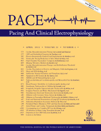Catheter Ablation of Accessory Pathway in the Treatment of Pacemaker-Mediated Tachycardia
Disclosures: None.
Abstract
Pacemaker-mediated tachycardia (PMT) remains a clinical problem in patients with dual-chamber pacemaker despite technological advances. The onset mechanism of this tachycardia is sensing of retrograde atrial activation after ventricular stimulation. Repeated retrograde conduction perpetuates tachycardia. Postventricular atrial refractory period prolongation has been used for prevention of PMT, but this is not the solution in all cases. We present a case with PMT where the retrograde limb is a left accessory pathway, which is treated with radiofrequency ablation successfully. PACE 2012; 35:e84–e86)




